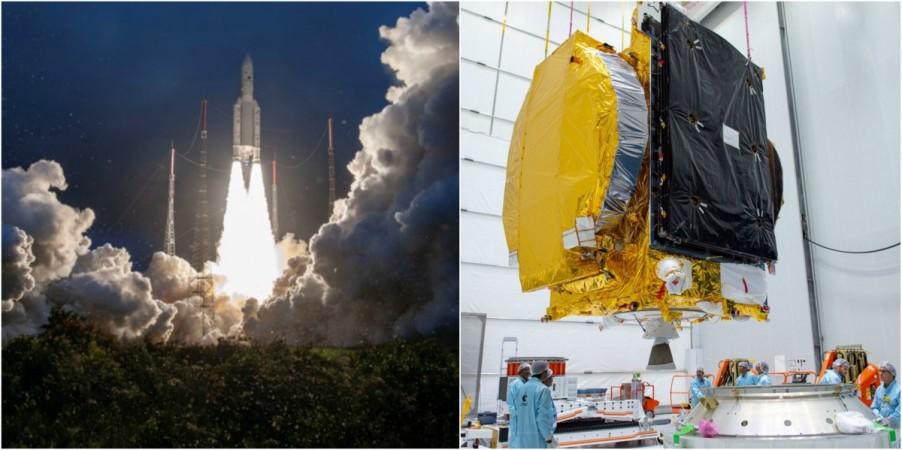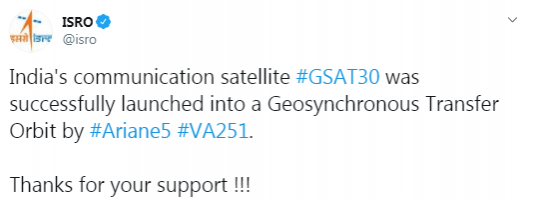
India's high power communication satellite GSAT-30 was successfully launched from the Spaceport in French Guiana during the early hours on Friday, January 17 with its heavy-lift of Ariane 5 rocket. The launch vehicle Ariane 5 VA-251 lifted off from Kourou Launch Base, French Guiana at 2:35 am IST carrying India's GSAT-30 and Eutelsat Konnect.

According to the Indian Space Research Organisation (ISRO), the 'flawless flight' lasted about 38 minutes and 25 seconds. After the flight, GSAT-30 separated from the Ariane 5 upper stage in an elliptical Geosynchronous Transfer Orbit.
GSAT 30 will replace INSAT-4A in orbit

With a lift-off mass of 3357 kg, GSAT-30 will provide continuity to operational services on some of the in-orbit satellites. GSAT-30 derives its heritage from ISRO's earlier INSAT/GSAT satellite series and will replace INSAT-4A in orbit.
Isro chairman K Sivan said in a statement, "GSAT-30 has a unique configuration of providing flexible frequency segments and flexible coverage. The satellite will provide communication services to Indian mainland and islands through Ku-band and wide coverage covering Gulf countries, a large number of Asian countries and Australia through C-band."

GSAT-30 will provide:
- DTH Television Services.
- Connectivity to VSATs for ATM.
- Stock-exchange.
- Television uplinking and Teleport Services.
- Digital Satellite News Gathering (DSNG)
- e-governance applications.
- The satellite will also be used for bulk data transfer for a host of emerging telecommunication applications.
This was an excellent start of 2020 with an excellent launch using Ariane 5 - the most reliable launcher - P Kunhikrishnan, the Director of ISRO's UR Rao Satellite Centre.
"On behalf of the ISRO Chairman, I want to thank Arianespace for a wonderful and professional job - both in the preflight preparations and during the launch," P Kunhikrishnan added.
ISRO's Master Control Facility (MCF) at Hassan, Karnataka took over the command and control of GSAT-30 immediately after its separation from the launch vehicle. Preliminary health checks of the satellite revealed its normal health.
Satellite to be operational after completion of all in-orbit tests
In the days ahead, orbit-raising manoeuvres will be performed to place the satellite in Geostationary Orbit (36,000 km above the equator) by using its onboard propulsion system.
During the final stages of its orbit raising operations, the two solar arrays and the antenna reflectors of GSAT-30 will be deployed. Following this, the satellite will be put in its final orbital configuration. The satellite will be operational after the successful completion of all in-orbit tests.
#Ariane5 will deploy its two satellite passengers on a mission lasting approximately 38 minutes and 25 seconds from liftoff to final payload separation. #VA251 pic.twitter.com/6H6S846SAw
— Arianespace (@Arianespace) January 16, 2020
GSAT-30, 24th ISRO satellite orbited by Ariane-series launchers
The GSAT-30 was the 24th ISRO satellite orbited by Ariane-series launchers, tracing the relationship back to India's APPLE small experimental communications spacecraft, lofted in 1981 by an Ariane 1 version, said Arianespace.

According to Arianespace, the Friday's successful launch kicks off its busy launch schedule in 2020, which targets a record mission count - with up to 12 opportunities identified from Europe's Spaceport in French Guiana using Ariane 5, Soyuz or Vega; along with the maiden flights of Ariane 6 and Vega C; plus eight more from the cosmodromes at Baikonur and Vostochny.
Arianespace's next launch - Soyuz Flight ST27, scheduled for early February - will orbit OneWeb constellation satellites from Baikonur. This is to be followed by another February mission - Ariane 5's Flight VA252 from French Guiana - carrying JCSAT-17 for SKY Perfect JSAT and GEOKOMPSAT 2B for the Korea Aerospace Research Institute (KARI).
















